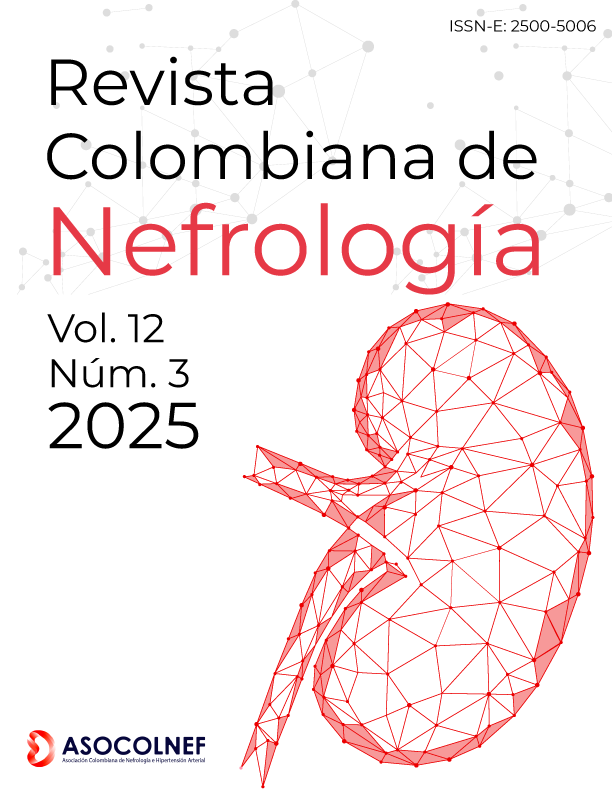Abstract
Purpose: This clinical case report aims to document the successful management of calcific arteriolopathy, also known as calciphylaxis, in a 74-year-old male patient with multiple comorbidities, including chronic kidney disease. The primary objectives were to highlight the effectiveness of a multidisciplinary approach -particularly the use of topical sodium thiosulfate- and to demonstrate the positive impact on glomerular filtration rate (GFR) following wound healing.
Methods: The patient presented with two ulcers on the posterior aspect of the right leg, which developed after hospitalization for congestive heart failure. A comprehensive treatment strategy was employed, involving multiple medical specialties, including infectious disease, nephrology, and dermatology. Treatment included intravenous antibiotics, pain management, transitioning to new-generation anticoagulants, and the use of a unique ointment containing sodium thiosulfate for wound care.
Results: After seven months, the patient achieved complete wound healing, and his glomerular filtration rate improved significantly. Three consecutive measurements of renal filtration parameters confirmed this positive impact. The topical application of sodium thiosulfate played a crucial role in wound healing, highlighting its potential as a treatment option for calciphylaxis.
Conclusion: This case underscores the importance of interdisciplinary management in calcific arteriolopathy, addressing both underlying causes and localized wound care. The successful outcome and improved renal function following wound healing suggest that topical sodium thiosulfate can be a valuable treatment approach, particularly when systemic therapy is challenging. This report contributes to the limited literature on the topical use of sodium thiosulfate in calciphylaxis and emphasizes the need for comprehensive care in patients with this condition.
References
Gallo Marin B, Aghagoli G, Hu SL, Massoud CM, Robinson-Bostom L. Calciphylaxis and kidney disease: A review. Am J Kidney Dis. 2023 Feb;81(2):232–9. https://doi.org/10.1053/j.ajkd.2022.06.011
Musso CG, Restrepo-Valencia CA. Arteriolopatíacalcificante (calcifilaxis). Recomendaciones para su manejo. Rev Colomb Nefrol. 2019;6(1):14-16. https://doi.org/10.22265/acnef.6.1.337
Martí Pelluch CC, Soler Sendra A, Vila Vall-Llovera M. Non-uremic calciphylaxis: Case series. Med Clin. 2023 Apr 6;160(7):318–319. https://doi.org/10.1016/j.medcle.2022.11.010
Westphal SG, Plumb T. Calciphylaxis. In: StatPearls. Treasure Island (FL): StatPearls Publishing; 2023.
Musso CG, Enz P, Vidal F, Gelman R, Lizarraga A, Giuseppe LD, et al. Use of sodium thiosulfate in the treatment of calciphylaxis. Saudi J Kidney Dis Transpl. 2009 Nov;20(6):1065–1068.
Musso CG, Enz P, Vidal F, Gelman R, Di Giuseppe L, Bevione P, et al. Oral sodium thiosulfate solution as a secondary preventive treatment for calciphylaxis in dialysis patients. Saudi J Kidney Dis Transpl. 2008 Sep;19(5):820–821.
Singh A, Tandon S, Tandon C. An update on vascular calcification and potential therapeutics. Mol Biol Rep. 2021 Jan;48(1):887–896. https://doi.org/10.1007/s11033-020-06086-y
Wen W, Portales-Castillo I, Seethapathy R, Durant O, Mengesha B, Krinsky S, et al. Intravenous sodium thiosulphate for calciphylaxis of chronic kidney disease: A systematic review and meta-analysis. JAMA Netw Open. 2023 Apr 3;6(4):e2310068. https://doi.org/10.1001/jamanetworkopen.2023.10068
Martín Navarro JA, Pedraza Cezón LA, de Pablos Martín MP, González Monte E, Polanco Fernández N, Gutiérrez Sánchez MJ, et al. Treatment with sodium thiosulfate in calciphylaxis of topical active renal transplant patient. Nefrología. 2016 Aug 29;36(5):579–581. https://doi.org/10.1016/j.nefro.2016.05.003
Requena S, Santos-Juanes J, Morales P, Gómez C. Therapeutic success of sodium thiosulfate in treating cutaneous calciphylaxis in a patient with hyperphosphataemic familial tumoral calcinosis. Australas J Dermatol. 2022 Feb;63(1):e75–77. https://doi.org/10.1111/ajd.13750
Abbott J, Kowalski EH, Klein S, DeShazo R, Hull CM. Iatrogenic calcinosis cutis secondary to calcium chloride successfully treated with topical sodium thiosulfate. JAAD Case Rep. 2020 Mar;6(3):181–183. https://doi.org/10.1016/j.jdcr.2019.12.017
Nowaczyk J, Zawistowski M, Fiedor P. Local, non-systemic, and minimally invasive therapies for calcinosis cutis: a systematic review. Arch Dermatol Res. 2022 Aug;314(6):515–525. https://doi.org/10.1007/s00403-021-02264-5
Müller C, Tanew A, Laml-Wallner G, Radakovic S. Successful treatment of calcinosis cutis with a topical sodium thiosulphate preparation containing 20% zinc oxide in a patient with sclerotic graft-versus-host disease. J Eur Acad Dermatol Venereol. 2022 Jan;36(1):e39–41. https://doi.org/10.1111/jdv.17610
Schultz GS, Sibbald RG, Falanga V, Ayello EA, Dowsett C, Harding K, et al. Wound bed preparation: A systematic approach to wound management. Wound Repair Regen. 2003 Mar;11(s1):S1–28. https://doi.org/10.1046/j.1524-475X.11.s2.1.x
Schultz G, Mozingo D, Romanelli M, Claxton K. Wound healing and TIME; new concepts and scientific applications. Wound Repair Regen. 2005 Jul-Aug;13(s4):S1–11. https://doi.org/10.1111/j.1067-1927.2005.1304S1.x
Atkin L. Chronic wounds: The challenges of appropriate management. Br J Community Nurs. 2019 Sep;24(s9):S26–32. https://doi.org/10.12968/bjcn.2019.24.Sup9.S26
Bowers S, Franco E. Chronic wounds: Evaluation and management. Am Fam Physician. 2020 Feb 1;101(3):159–166.

This work is licensed under a Creative Commons Attribution-NonCommercial-NoDerivatives 4.0 International License.


